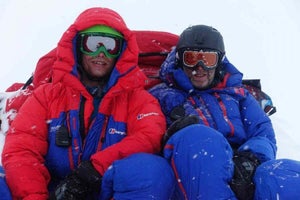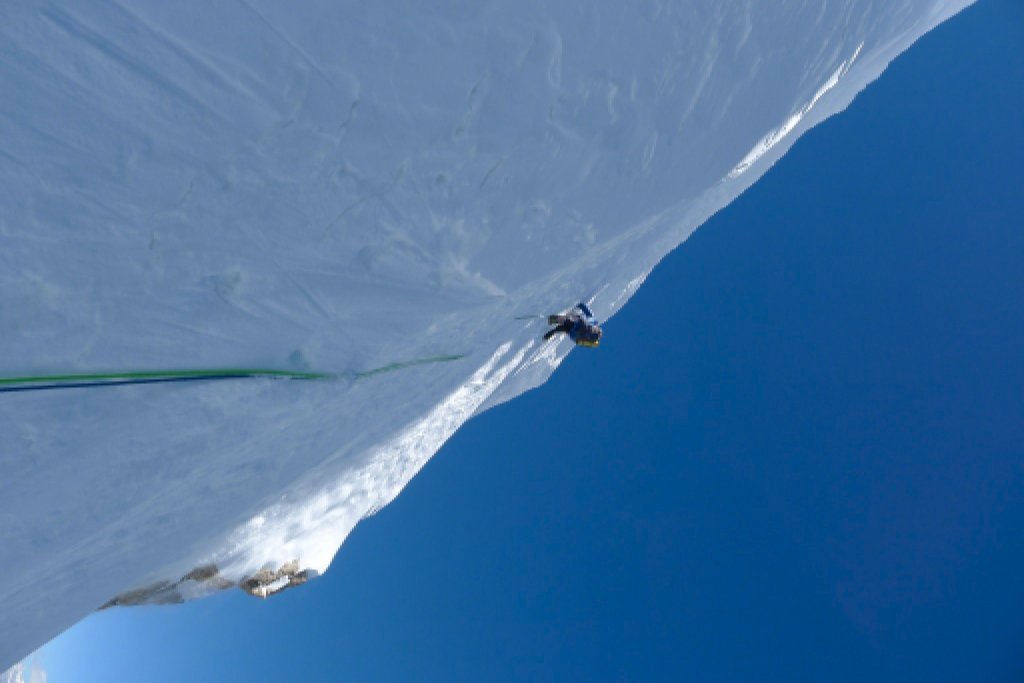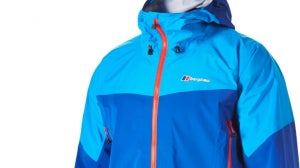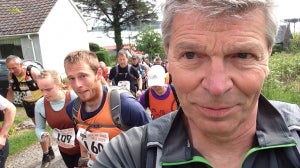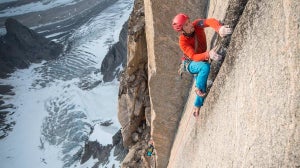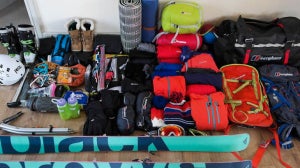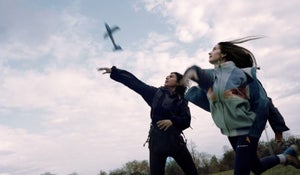
We need not have feared. The north face of Gave Ding reared up in a complex line of Eiger like walls crowned by a Peutery like ridge leading to a short but sharp headwall. Ice cliffs threatened both sides but in the centre there looked to be a single safe line.
First though some acclimatising was necessary and that became more than usually problematic. Our plan was to spend time up high in the unexplored side valley immediately opposite the north face of Gave Ding. This was ringed by unclimbed 6,000 metre peaks but as we gained a better overall sense of the area it became increasingly clear that the contrast between the north and south sides of the mountains here is extreme.
We were told it had been a weak monsoon and perhaps that was a significant factor but just about every face that was not truly north facing was snow free loose rubble up to a height of 5,600 metres or so. Water was a real problem. Above the lake where we had originally planned to have our base camp we could find no water at all. The glacier was completely covered in sun-baked tortuous moraine and no streams at all came down from the mountains above.
All in all we decided that the valley was one of the most dry and desolate glacial basins we had ever seen; we didn’t spend as much time as high as we would have liked and it was not our most successful acclimatisation outing. Paul and I could but hope that our bodies were ready for the altitude gain involved in climbing the 1,600 metre mixed face that towered above the far side of the glacier. At least it looked hard so we would gain height slowly and thereby stand a chance of acclimatising on the route. Positive thinking is important in Himalayan climbing.

After waiting out a couple of days of indifferent weather at base camp we were camped under the face with seven days food and four gas cylinders for the stove.
Our planned day one was to move together up a snow couloir and then traverse easily to a possible bivouac spot on a col between a pinnacle and the face. The traverse line turned out to be powder snow on slabs and very tricky in places but even so by early afternoon we were at our planned bivouac spot. The sharp crest sported no good spots for our little tent so we used a snow hammock to hold back as much of the powdery snow as possible and urinated on it in the vague hope that would help freeze everything together. This sort of worked and we ended up with the tent floor draped over a 50 centimetre wide crest of snow. Boots and other heavy stuff hanging in the fabric on either side vaguely stabilised matters but the ever possible chance of the whole show slipping off to one side did not make for the most relaxing of nights.
Above us the wall reared up in a series of blank Eiger like walls broken by discontinuous white streaks. After much discussion we had a plan and various fall back plans for this section. Plan A was a curling line of weakness leading to a distressingly steep section. If we failed on this plan B was to abseil diagonally out of the steep section to a parallel line further right. And Plan C was to traverse a long way back left to a line that looked harder – so Plan C wasn’t much of a fall back plan at all really.
A morning of awkward work on powdery mixed ground followed by delicate traversing put us above a huge drop below the main difficulties of Plan A. As I arrived at the stance Paul was hanging out from the belays craning his neck to get a good view of the tenuous line of weakness above.

‘Looks hard. Might just go.’
The position had become outrageously exposed. The ground below overhung for several hundred feet such that abseiling into Plan B was clearly a non runner. That meant we really had to get up the near vertical mixed ground above. Oh dear there was only one option. And it was my lead.

Much as I derive enormous amounts of retrospective pleasure from technical Himalayan climbing it is not often that the Fowler body yelps with delight at the time. Here though the situation was exceptional. The snow/ice conditions were now perfect, the protection reasonable and the climbing just within my limit.
‘Absolutely brilliant’ I heard myself shouting to no-one in particular.
It soon became apparent that the improvement in the conditions was due to the consolidating effect of the large quantities of spindrift that intermittently poured down this part of the face. But nothing was going to detract from my enjoyment here. And on the plus side the spindrift waves made for an excellent opportunity to test the neck and hood design of the proto type Extrem 8000 Pro jackets that we were testing for Berghaus.

Three fantastic pitches, including a memorable descent from a disturbingly unexpected cul de sac, led to an easing of the angle and a snow crest on top of a buttress which, almost uniquely in my experience, was soft and deep enough for us to quickly clear a platform that was only a little short of the size of our tent. It did collapse a bit in the night and bend the poles but we had expected a sitting bivouac and a bent pole seemed a small price to pay for the relative luxury of tented accommodation.
Above us steep mixed ground led to another rock band cleaved by another difficult looking line of weakness. By now we were fully appreciating the fact that the face was very truly a north face. We had had no sun whatsoever since crossing the bergschrund three days earlier and the temperature was stubbornly low.

Paul persevered out of sight as I shivered. Soon he reported that he was leaving his rucksack hanging on a runner. Never a good sign that. We both like to avoid the faff of hauling if at all possible. The problem was ice too thin for secure protection stretching a long way up a near vertical groove. Seconding on a single 7 mm rope I couldn’t help but be aware that a) the rope looked very thin and b) the sack being hauled on the other rope was making much smoother progress than me. It was a pity I couldn’t get any photos of Paul leading such a spectacular pitch. But I did manage to snap a shot of his sack.

By now we were well up the face with excitement levels growing. We seemed to be correct in our judgement that the line was completely safe from objective dangers and the climbing was turning out to be even better than we had expected. And to end an excellent day we found a perfect tent ledge beneath an ice cliff just as we were resigned to a sitting bivouac.
Not far above us was the start of the Peuterey ridge like section. The Peuterey ridge on Mt Blanc is a classic of its genre and with a sharp icy crest in a superb position this bore many similarities to my experience of the upper section of that route. And here we were to welcome the sun for the first time in four days. Mind you it seemed to have very little warmth in it and we were already commenting that the conditions were amongst the coldest we had experienced on our climbs together.

At the end of the ridge a 20 metre ice wall gave access to a small hanging glacier below a 150 metre headwall of cornice fringed, hard blue ice. This looked challenging but with gathering clouds our first priority was to get the tent up. Thus far the weather had been good with afternoon snow showers clearing by nightfall. Now though darkness fell with snow falling heavily. Soon the wind picked up and the snow accumulated so that the walls of the tent pushed heavily against us. I lay awake deep into the night listening to the sound of the wind and snow. I didn’t sleep well.
It was a relief when morning dawned clear and calm but bitterly cold. We guessed the temperature could be as low as minus 30 degrees Celsius. Around 75 centimetres of new snow had fallen and the snow line was way below base camp. In places the powder snow was chest deep and it was a fine, energy sapping effort by the Ramsden to trail break a trench to below the headwall.
The hard blue Himalayan ice here was of the kind that only those who have experienced it can fully appreciate. By now our axes and crampons were blunt and bounced ineffectually off the ice. At one point the enormous effort required to get secure axe placements saw me reduced to clipping into the base of my axe and hanging sack like against the ice. Exhausting stuff this Himalayan climbing. And the cold was such that this turned into the only climbing day ever that Paul, who seems largely immune to the cold, has worn a down jacket all day. We were testing new versions of the Ramche jacket and, as someone who has increasing problems with the cold, I was particularly grateful to those nice innovation people at Berghaus who have somehow made it even warmer and lighter than earlier versions.

The summit crest came suddenly. After five days of hard climbing on the steep and inhospitable north side it felt like something of a release to pull into the sun, have a whole new panorama open up and be able to walk about freely on the relatively amenable southern slopes. The summit was easily reached and a firm summit hug felt to be in order.

We pitched our tent in a good spot just below the top and enjoyed spending the last few hours of daylight soaking in the wonderful view of unexplored terrain and relishing the feeling of having completed the climb that we had dreamed of for the last year. We wondered how close the nearest other climbers were – and concluded that it was a very long way. The remote grandeur of our position felt very special.

All we had to do now was get down. That took a further two days involving complex glacier travel on the south west side, 25 abseils from abalakov threads on the north side and four absolutely exhausting hours crossing the glacier and descending to base camp.
Once down I soon fell asleep and spilled my dinner in my lap. Before that though we had agreed it had been one of the very best climbs that we had done together. And as we walked down through the changing seasons of old growth deciduous forests I knew already that the retrospective pleasure of such a fine trip would stay with me for many years.
Adventures in the remote Himalaya are difficult to beat.
Discover the 14 hour drive from Kathmandu followed by a 4 day hike to base camp in part one of Mick Fowler’s two-part Gave Ding series

Related Articles
